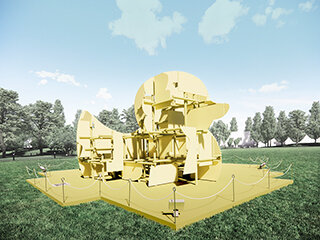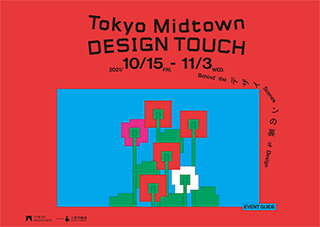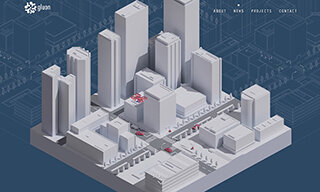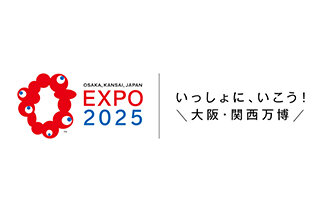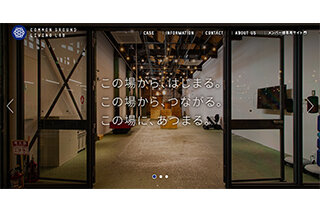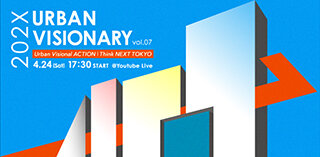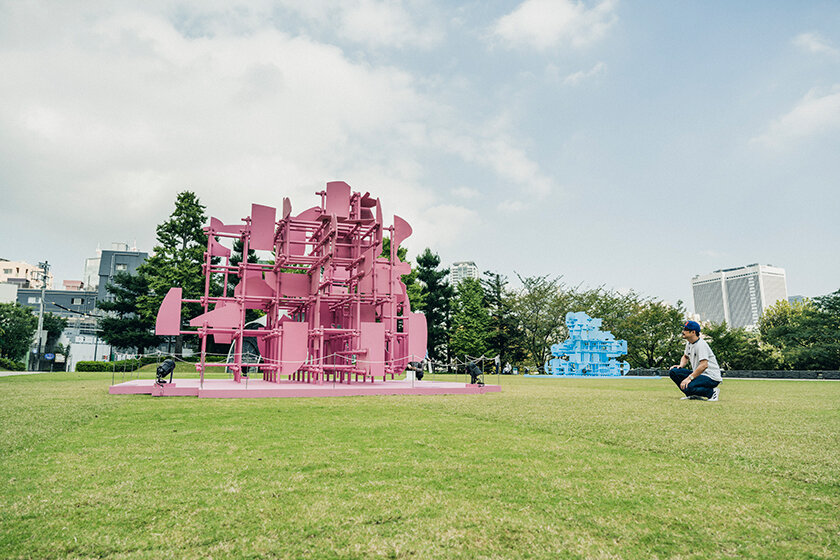
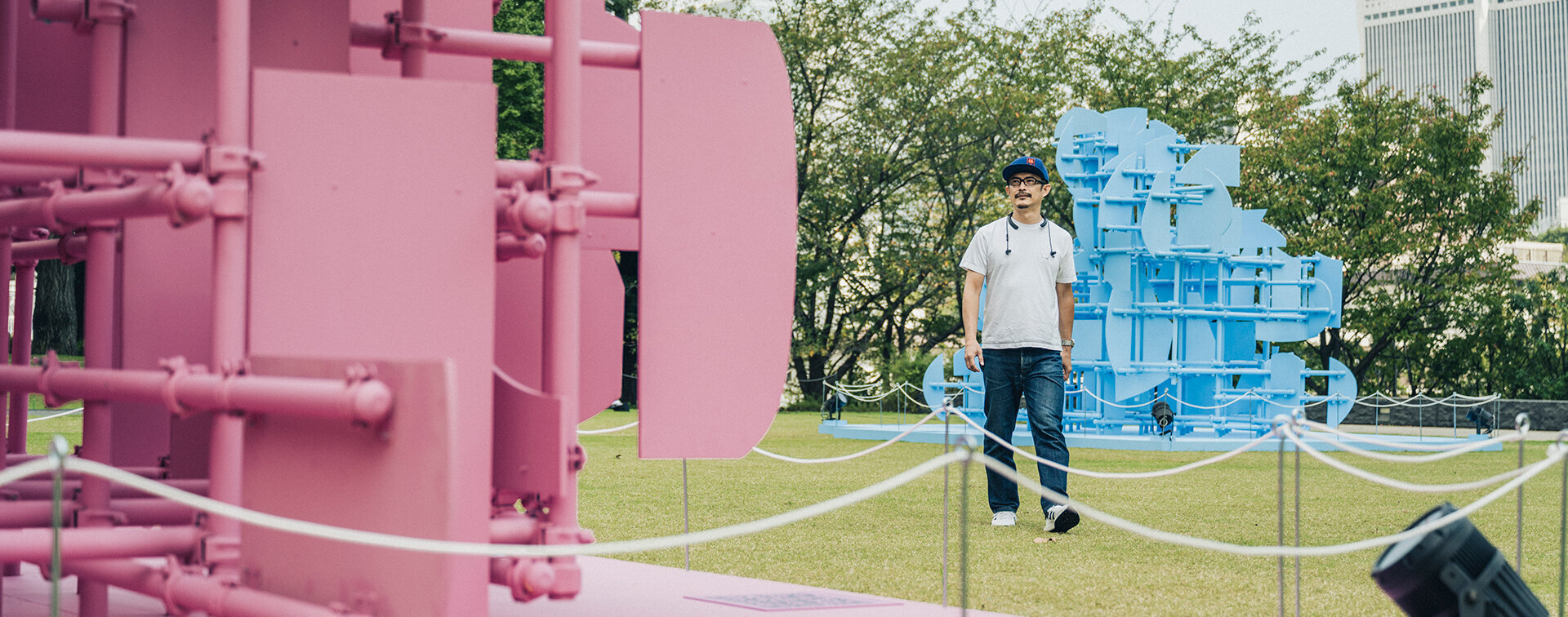

INTERVIEW
130
Keisuke ToyodaProject Professor at Institute of Industrial Science, The University of Tokyo / Architect
Creating The Roppongi Common Ground Research Institute
Enjoying the colorful gradient between the real and the digital
Architect and Project Professor at The University of Tokyo’s Institute of Industrial Science, Keisuke Toyoda is known as a standard bearer for computational design that combines design with digital technologies. He says the future of architecture and cities is one where the real and digital realms will connect seamlessly, and refers to the shared infrastructure to achieve this as “common ground”. Here I talked to Keisuke about how the creation of this common ground will change our lives in his vision of the near future, and why Roppongi is the perfect place for it.
A gradient, not a dichotomy
I speak from the position of an architect who deals with real things and has recently started to do research at the university as an extension of this. But from this position I proactively convey to people about how interesting digital technology is and the potential of virtual space. Even though we have long been living in an information society and digital technology has advanced as far as it has, there is still a strong tendency for people to look at things as being either digital or analog, and people still sometimes say to me "oh that's because you're one of those digital types!" This sometimes makes me think that there still might be a hurdle to overcome here. So I really want people to understand that what I'm talking about does not in any way mean that we should ditch real things and live purely on information alone. It is not a dichotomy between the digital and the analog or between things and information; it is a gradient.
As the resolution of this gradient increases, we will be able to choose things that are entirely on the digital side while also being able to choose a variety of ways to combine the digital with the analog. The process of combining things with digital technology will most certainly make us see once again how rich real things are, and how interesting they are. So what I really want now is for everyone to first gain a variety of experience on this gradient.
With regards to the background to the works at this Tokyo Midtown DESIGN TOUCH event, it has been a year since the 2020 event was postponed due to the COVID-19 pandemic. As such, the works that were originally completely on the digital side of things have now been deliberately rethought from a real-world perspective. The pandemic brought drastic advances in our use of digital technology through remote working, online classes at university, and in other such forms, and I realized that for certain goals and in certain areas, the incorporation of virtual visual information is more than enough to deliver the value that is normally obtained.
unnamed -Design to be seen from different viewpoints-
This installation at Tokyo Midtown DESIGN TOUCH 2021 is from noiz architects, where Keisuke worked for many years. While the structures appear to be formed from randomly placed panels, a chick and a range of other forms become visible from certain positions as the viewer walks around the installation.
photo:©noiz
Tokyo Midtown DESIGN TOUCH
Tokyo Midtown DESIGN TOUCH is a design event held annually in fall at Tokyo Midtown. The theme of the 2021 event is "Behind the Scenes of Design", and focuses on the process behind completed designs to understand the perspective of designer as they worked on solving their design challenges. The event this year runs until November 3rd (Wednesday).
https://6mirai.tokyo-midtown.com/event/design_touch_2021/
However, it is also true that I got a keen feeling for the value of real things and spaces that can only be obtained by going to where they are. The richness of physical material is overwhelming. Information that can actually be described digitally, externalized, and used is very limited, and in comparison with the magnitude of information from real things it still has not even reached the stage of development of a newborn.
And that's exactly why it would be great if people came to this event, phyically moved around and got a feeling for the texture of these physical materials, and in doing so realize that there is a lot of information that we can extract from the real world. In the same way that information sometimes shows us how interesting the real world is, the real world can sometimes show us the potential of information. What I am trying to say here is that I want us to play more and more in the space between the real and digital realms.
Increasing the potential of experience without being limited by location
When it comes to envisaging the future of architecture and cities, the thing I feel has the most potential at the moment is the design of infrastructure that enables the seamless connection of the physical world with information (i.e. the digital world). This infrastructure is the "common ground." This is a challenge for us to create a shared infrastructure, or environment, that can be utilized equally by both humans themselves and digital agents such as robots and avatars.
Common ground
Common ground is a platform where 3D data taken for buildings and cities in the real world is used to seamlessly connect the physical realm and the digital realm, and to create a linked, overlapping physical and digital space. Keisuke Toyoda has also established a cross-area platform called "gluon" with Mitsuhiro Kanada, and this platform focuses on architecture, cities, tech, and business.
photo:©gluon
A one-off opportunity to succeed in this challenge will arrive in 2025 in the form of the Osaka, Kansai Expo. I was involved in the expo in the roles of Venue Planning Advisor and an expert on the PLL Committee, and it is a once in a lifetime chance to build a demonstration virtual city to experiment with over a limited period of six months in a specific location.
Japan World Exposition
The Japan World Exposition will be held in Yumeshima, Osaka, in 2025, and Keisuke Toyoda served as a Venue Planning Advisor for the expo. The theme of the expo is Society 5.0, which is to be achieved through maximized use of ICT, and it will show what a future society with super-smart cities will look like.
At expos up to now, the number of visitors has been the number of people who physically come through the gates, and the only way to attend an expo was to actually go to it. However, if you consider that interaction and contribution are part of the value of an expo then actually going to the venue is not the only way to be involved. It is now possible to make a virtual venue, and if you could make an expo venue within the game "Fortnite" it wouldn't be a case of having just 28 million visitors come to the venue; you would be able to get many.
Separating the virtual from the real is already an old way of thinking and we now have to think about how much we can integrate the two, but let's say that a ticket to actually get into the expo was 8,000 yen while an augmented body ticket cost 5,000 yen. In return for paying for a ticket costing 5,000 yen, a person will provide their own body as an avatar for a remote visitor for the two hours between one o' clock and three o' clock, and if you add devices and a translation service to that then for those two hours, the person could share the same body with a farmer's children in the mountains of Argentina and share the experience of going around the venue together, and things like that.
It is highly unlikely that the children of a farmer in the mountains of Argentina would be able to attend an expo in person. But if common ground was put in place, then they would be able to put themselves in the body of another person or into an avatar robot made available for remote connection. And this would enable them to participate in a new generation of expo in close communication with their host body. While the virtual experience maybe shallower than being there in real life, it may provide another kind of value. And in comparison with the 5% experience of just watching on TV or on the internet it may provide an experience that is equivalent to 30% or 50% of the original, but either way it provides an experience with a greater level of intensity than anything before. This increase in the potential of experience is both the what makes the construction of common ground good, and its goal.

Towards a world with more choices through the construction of an informational environment
The expo is a venue for a demonstrational experiment, and I think experience that is not limited by location can drastically change the way we live henceforth.
For example, there are plenty of people who were born in rural areas but who have no choice but to move to Tokyo from the perspective of their workplace and their children's education. I think that if you asked these people whether they 100% want to live in Tokyo, they'd say something like they 50% don't mind, 30% would rather live where they are from, and 20% want to bring up their kids near the sea. But we are still in a society that forces them to choose 100 or 0, so ultimately, they have no choice but to live in metropolitan areas.
If they want to 10% of daily life for their kids to experience rural life, learn traditional culture, and learn about the environment in a natural setting then they should have that chance without having to be the kind of mega-rich person who could physically shuttle between urban areas and the countryside by jet. And if a place with common ground was established that completely seamlessly and equally linked the city to the countryside then the life choices available to them would increase significantly. In the same way that there is a world that is not available if it is restricted to the physical realm, I think there are many situations where choices become all or nothing if they are restricted by location.
The role of an architect is to create an environment. The type of environment traditionally handled by architects is physical environments, and in a way they are too enclosed within this environment. Of course, physical environments are assets and they protect the safety of humans as living creatures, and while this is important, informational environments are very much realistic possibility in our current society. I think the role of architects is also to explore the overall form that these should take and present their vision.
Designing new areas and individuality with a multi-focus approach
Up to now, architects had tended to have a puritanical aspect and focus too much on only a single path based on established evaluation criteria in the architecture industry. But in order to contribute to society as a whole, I think it's important to have multiple focal points in intermediate areas, that is, to focal points that span areas whose evaluation criteria is fixed.
For example, if you talk about video games and architecture, anyone would treat them as different areas. We often talk to people in the games industry and the technical evolution of game engines is tremendous, but when it comes to discussions about linking these in the real world, their thinking inevitably goes back to the game world. This is despite the fact that really interesting potential lies in a fusion of thinking, rather than having an architect's brain for architecture and a games brain for games. So that's why we really try to stimulate and inspire each other to explore intermediate areas while recognizing each other's expertise.
In order to explore intermediate areas, both sides need to understand each other. And they must be able to indicate the kind of value they can bring while being able to have proper technical conversations. So, I think that going forward, having several specialties is going to be a very important capability - to have many focal points instead of a single focal point. Rather than having a broad and even but shallow knowledge of a range of areas, I mean having two or three areas you can call your specialties, and then designing new areas and individuality from withing a triangle of square shape that straddles these. I think this is the type of capability that will be demanded of architects and designers going forward.
I think double majors at universities and things like that should be pushed more. And "studying abroad" can take the form of study that extends across specialist areas instead of straddling international borders. The more people you have who follow paths like, for example, graduating from an architecture faculty and going on to learn molecular biology before experiencing the world of fashion and then returning to architecture, the more that creative potential will grow.
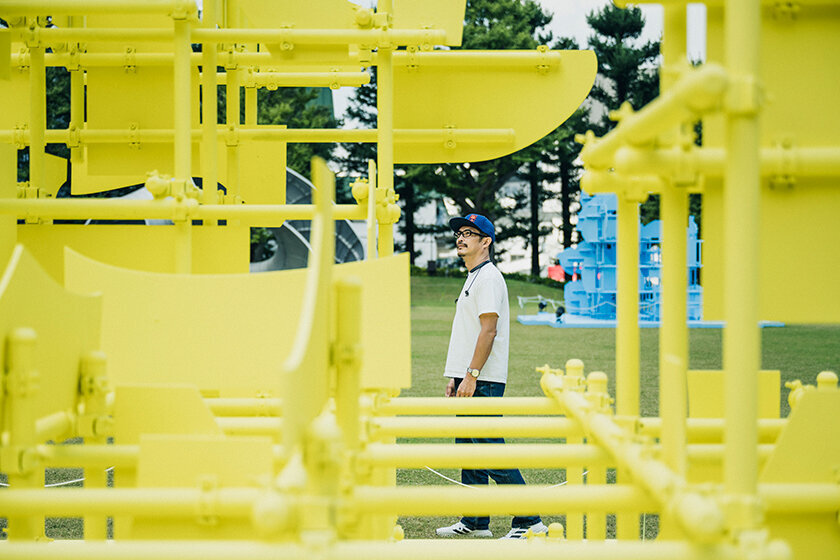
A design for new contracts and rights is required
When it comes to creating an environment to seamlessly connect the physical world with the digital world, there are initiatives known as "smart cities", and "digital twins" that recreate the actual world in digital space.
I am actually involved in studies with a few developers, and just by saying something simple like I'd like to use digital twinning to create a virtual Roppongi you get presented with questions like what will happen to each of the individual rights for the area? And who is going to undertake maintenance and management, and who is going to run everything in what way? There is still no one who has the clear answers for these questions.
Ultimately, what causes problems is not technology, but rather contracts and rights. What usually happens is that firstly the laws aren't in place so the government puts them in place, but they are created in a flexible way so depending on the way you think and your approach you end up being able to get done what you want to get done. What doesn't end up getting sorted are contracts between private parties and issues relating to rights, which tend to be based on the old enclosure-type thinking. So despite the fact that there's a nice new intermediate area, if things just go the way they are now, the project will only go in a direction where it gets ruined. What I mean is, in order to design a virtual town, we need to design new forms for contracts and rights.
As well as this, there are also lots of things that we can't do unless it's in consultation with landowners and businesses involved in the area. So in Osaka we had the Osaka Chamber of Commerce and Industry take the lead and launched the "Common Ground Living Lab" to bring different industries together and explore the potential of a virtual town. I think things would get extremely interesting if we could also do this in Roppongi.
Common Ground Living Lab
Common Ground Living Lab was launched as a venue for practical experiments for services and products aimed at smart cities, such as self-driving technology and AR/VR. It has a shared experiment space with facilities including shared offices and sensors, allowing a range of companies to work together on experiments and research on a daily basis.
https://www.cgll.osaka/
Roppongi is suited to the creation of a platform for common ground
The reason I feel that Roppongi is so amazingly unique is that it has at its core the power players of the Mori Building and Mitsui Fudosan, while at the same time also hosting a ramshackle world of main streets and back streets. It is this variety that makes it unique.
For the purpose of initially implementing shared infrastructure, or common ground, that seamlessly links the real world with the digital world, I think a place that is thoroughly organized like Roppongi Hills or Tokyo Midtown would be the easiest to do it. But once a common ground platform is built in Midtown there is no need for the services provided in it to be limited to Midtown, and people in the mixed-use buildings and office nearby could use AR (augmented reality) conference services or, conversely, the people in Midtown could get lunch delivered from nearby stores. There are a range of advantages to be shared.
Once the core is initially in place, people nearby can jump on board in a form with many choices, so I really feel that Roppongi, with major developers at its center, is very suited to the creation of common ground. What's more, the budget for building a platform for a virtual town will be no more than a hundredth or a thousandth of the budget for the redevelopment of physical space that we have seen so far. Roppongi really is suited to this, so it would be a real shame not to do it.
With that said, my proposal is to create a "Roppongi Common Ground Research Institute" to bring people from a range of industries and businesses together, and discuss rights for digital twins, the form management should take, and other such matters with the tentative goal of implementation in 10 years' time. In addition to this, it would be very interesting if we were also able to include the Mori Building, Mitsui Fudosan, and The National Art Center.

The Roppongi Common Ground Research Institute to Envision the Future
I think that what will be very important for companies going forward is an R&D (research and development) function. I think that the government also needs to have an R&D function, but developers should also have a proper research institute to bring together researchers who perform technological development. Mori Building has its Institute for Urban Strategies that publishes the Global Power City Index and has a research function for economic trends, and I think that it will be impossible to produce a vision of the future without a research institute that will take a platform for a virtual city seriously and create one as a program.
At the end of the day, the work of architects is to create an image or vision of what they think is possible. While creating such things is difficult, they don't have any capabilities to take the vision and make it real. To take things forward, a research and development function is needed and if "Roppongi Common Ground Research Institute" were to be created, Roppongi would be able to take action to become a world leader and place itself at the very cutting edge.
Take, for example, Tokyo's Shibuya district, where Tokyu Land Corporation has started a project called "Urban Visionary" with research and study groups. You see a range of the same type of movements in various places, but still nowhere can you find an organization with the staff and budget to implement these things. Instead of just discussing the potential of digital transformation, in other words the spread of IT, to change people's daily life in a good way, isn't it about time we had an organization to bring this to fruition, and secure the human resources to embark on creating development capability?
202X URBAN VISIONARY
This is a talk session that came about through a call from Seiichi Saito (of Panoramatiks), where major developers including Tokyu, Mori Building, Mitsubishi Estate, and Mitsui Fudosan discuss a future vision for cities amidst major urban development in Tokyo.
Climbing the steps through fun rather than correctness
Another thing that I think is important in terms of how to climb the steps to the implementation of an information environment in society is proactively trying things out in the fields of events and entertainment. I've talked a lot about the advantages and necessity of common ground, but things won't proceed if we insist on doing things "properly". Doing things "properly" always means that you get people with a different version of properly who criticize what you're doing. But there is no way you can deny it when people are having fun. Nobody ever says anything like "you are having fun, but really you aren't enjoying yourself." It's easier to move things forward through enjoyment rather than correctness, and this enjoyment aspect dovetails perfectly with the games industry. So that's why I currently feel the greatest potential is in just how much this aspect can connect to enjoyment precisely because there is a physical space.
From the perspective of fun, one aspect of the value that commercial facilities such as Roppongi Hills and Midtown have is, again, enjoyment. This also goes for events such as DESIGN TOUCH and Roppongi Art Night. This might be a bit of a rough was to see things, but with one off events it doesn't matter very much if they are a failure and they tend to get funded more easily. I think we need to repeatedly do events that are indeed events when seen from the outside, but are actually a demonstration experiment for digital twinning or something like that and behind the scenes researchers are also actually involved.
So in this respect as well, Roppongi, with its ability to host events at Roppongi Hills plaza or the garden at Midtown, offers the chance to easily build up know-how and is in an excellent location. The government, also, shouldn't just be saying things like it's not good for only one company to make profit, and should instead start dishing out subsidies. In terms of doing demonstration experiments for digital twinning, doing something at a level like budgeting five billion yen a year and enabling national research institutes to work together on them is what will bring change to society, I think.
Photos taken at: Tokyo Midtown DESIGN TOUCH 2021《unnamed》 (Currently running until November 3, 2021)
Editor's thoughts
Despite the fact that checking the real-time location of a taxi that I called using a smartphone app, participating in online meetings and doing remote interviews is now a part of everyday life for me, when I hear "a future where the real and digital realms will connect seamlessly", I skeptically wonder just what this has to do with me. But through this interview enabled me to rediscover that it is no longer the time for skeptically wondering, and is time to consider what kind of society to aim for and what value we will discover when the information environment develops a couple more steps as something that concerns me. The Osaka, Kansai Expo that Keisuke says presents a once in a lifetime chance as a venue for demonstration experiments for common ground is three years away, so the door to a new type of experience will be upon us relatively soon.(text_tami okano)
RANKING
ALL
CATEGORY




